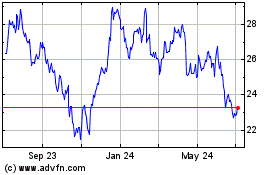BEIJING—China's leaders are forging what may soon be the world's
largest steelmaker, sticking to their conviction that big is good
and gigantic is better for state-owned firms.
The merger is the latest Chinese effort to create "national
champions" that can compete globally and trim excess production
capacity to adapt to falling demand. It comes as Beijing faces
growing international complaints over cheap steel exports.
But such efforts haven't aided efficiency in the past. And the
consolidation has entrenchedstate-owned enterprises in their
strategic positions of power in the economy, despite Beijing's vows
to develop a greater role for the private sector.
Through cheap loans and state support, Beijing has tried for two
decades to nurture industrial giants, creating the world's largest
rail-car maker and other behemoths. Yet, social and political
factors, such as keeping people employed to avoid social unrest,
have often trumped commercial ones such as shutting down production
to stem losses.
Meanwhile, the efficiency of China's heavy industry continues to
fall. In the oil-processing and steel sectors, for instance,
one-third of capacity remained unused by the start of this
year.
In the latest effort, China's two largest steelmakers, Baosteel
Group Corp. and Wuhan Iron and Steel Group Co., or Wisco, confirmed
on Tuesday their plans to merge. Baosteel's 130,000 workers are
nearly as many as in the entire U.S. steel industry.
If China adds one or two more mills into the mix, as officials
and analysts expect, the merged company's output would eclipse the
world's top producer, Luxembourg-based ArcelorMittal SA.
"This is the inevitable way to deal with falling demand, and it
will help the stable development of the global steel industry,"
said Dai Zhihao, president of Baosteel's listed subsidiary.
The companies declined to respond to requests for comment,
citing stock-exchange rules. Ma Guoqiang, a Baosteel veteran now
chairman of the heavily-indebted Wisco, told the official Xinhua
News Agency in July that "true restructuring" was needed to reduce
overcapacity.
"Megamergers don't necessarily lead to good restructuring," he
said.
Chinese mills, including Baosteel and Wisco, have committed to
cut 45 million metric tons of capacity this year and 150 million
tons over the next five years. But past attempts failed when
mothballed mills were reactivated as steel prices rose.
Instead, as China's economy slows and global demand for its
products shrinks, the government is again using consolidation to
assert control over unruly industries that haven't responded to
market forces.
Despite a global freight glut since 2011, two state-owned
shipping companies commissioned ever-larger ships, losing money
even as its global peers boast a 3.3% profit margin, according to
HSBC. The solution? Beijing merged them this year to create the
world's fourth-largest such company.
The government whittled its heavy-industry companies from 196 in
2003 to 112 last year. It aims for less than 100 by year-end.
The steel merger approach extends policies in place since 2004
and mirrors the last big round of megamergers at the height of the
financial crisis in 2009. To widen the reform process, Beijing has
recently also tried selling more of its noncore oil assets. Yet,
the twin goals of trimming excess and creating more competitive
global companies never came to pass.
Over the past decade, for example, China's largest steel mills
have become steadily less efficient than their peers in the U.S.,
Japan and South Korea. Return on assets fell to -3.6% in 2015 from
16% in 2004 at Wisco's listed subsidiary and only somewhat better
at Baosteel's listed arm. Nucor Corp., the largest U.S. mill,
showed return-on-assets of 4.7% last year.
China also lags behind in productivity. A worker at Baosteel
makes about 269 metric tons of steel a year, company data show. Its
largest global peers produce about 440 tons.
Global steel giants have laid off thousands of workers to cope
with recent downturns. Beijing says it prefers consolidation to
avoid mass retrenchments.
China struggles to close even the most obvious target in its
campaign—smaller and heavily polluting mills, leaving the sector
fragmented. China's top 10 steelmakers accounted for 34% of total
output in 2015, down from 53% in 2011 and well short of the
official target of 60%.
Turning these companies around would make a showpiece for
Beijing as it tries to rebut allegations from the U.S. and Europe
that it is overproducing and dumping cheap steel on world markets,
driving down prices. The trade brawl is clouding China's bid for
global stature and access to overseas markets.
Chinese officials say the country's steel is competitively
produced. They have also made a show of dismantling mothballed
furnaces, including one mammoth mill in Inner Mongolia last
month.
But gains in efficiency ultimately appear not to be a priority.
"State companies must be big, strong and good enough not to be
shaken" by global competition, President Xi Jinping said last
year.
Above the rutted roads of Muchangkou, a soot-blackened hamlet in
China's northern steel belt, smoke has begun wafting anew from the
red-and-white chimneys of the area's dozens of privately held mills
after more than a year of state-imposed suspension.
Local officials depend on these mills, usually the largest
employers, for revenue and kickbacks, workers and analysts say.
Local officials close the mills under pressure from Beijing but
often later let the factories reignite output.
"Lots of smaller mills in the area have revived production,"
said Liu Haibo, a 47-year-old steelworker who was laid off from one
Muchangkou mill early last year and re-employed by another this
month. "The local government won't let them fail."
Liyan Qi contributed to this article.
Write to Chuin-Wei Yap at chuin-wei.yap@wsj.com
(END) Dow Jones Newswires
September 20, 2016 23:05 ET (03:05 GMT)
Copyright (c) 2016 Dow Jones & Company, Inc.
Arcelor Mittal (NYSE:MT)
Historical Stock Chart
From Mar 2024 to Apr 2024

Arcelor Mittal (NYSE:MT)
Historical Stock Chart
From Apr 2023 to Apr 2024
